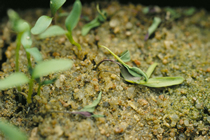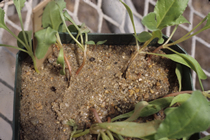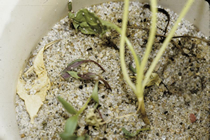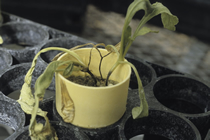By Robert Harveson, Extension Plant Pathologist
Pathogen
Rhizoctonia solani Kuhn, teleomorph: Thanatephorus cucumeris (A. B. Frank) Donk, Aphanomyces cochlioides Drechs., Pythium ultimum Trow, Pythium aphanidermatum (Edson) Fitzp., Phoma betae (A. B. Frank), teleomorph: Pleospora bjoerlingii Byford. All of these seedling pathogens can additionally be involved with root rot diseases throughout the season, however, the two most important pathogens consistently causing both seedling and root rot diseases include Rhizoctonia solani and Aphanomyces cochlioides.
Disease Symptoms
R. solani causes both pre-and post-emergence damping-off, but is most often observed causing disease on emerged seedlings.Infection begins as dark brown lesions below the soil surface and progresses up the hypocotyls, often resulting in wilting and complete collapse of cotyledons and death of plants.Infections from A. cochlioides begin near the soil line as water-soaked lesions that progress from gray to black. Stems become characteristically dark, thin and thread-like with an absence of cotyledonary wilting, which are the major criteria for distinguishing from R. solani infections.


Both Pythium spp. can cause pre- or post-emergence damping-off, depending on soil moisture and temperatures. Post-emergent damping-off symptoms of either Pythium species are indistinguishable from those of R. solani, and consist of wilting, lodging, and death of seedlings. Symptoms of Phoma seedling disease consist of dark brown to black necrosis on hypocotyls, often studded with small black pycnidia (200-325 μm). Little infection occurs above 78 F. Affected seedlings may often survive and recover to varying degrees, but the pathogen is also capable of persisting in the crowns and causing leaf spots, root rots, and storage rots in harvest piles later in the season.


Favorable Environmental Conditions
Management
Genetic Resistance
No genetic resistance is currently available for seedling disease problems due to these pathogens. Although root rot tolerance is available for several of these pathogens, the resistance is not expressed until later in the season.
Cultural Practices
Planting early into cool soils will help avoid or escape disease problems from all pathogens with the exception of P. ultimum, which could still occur in cooler soils. However, getting the seedlings established and growing vigorously before soils begin to warm, will help to withstand infection later if it does occur. Managing weeds and rotating crops will also help to reduce initial pathogen inoculum for sugar beets.
Chemical/Biological Control
Chemical seed treatments are readily available for protecting against all pathogens.Unfortunately no one fungicide will inhibit all pathogens, thus some knowledge of disease history in fields would help to make the best choice for treating if necessary. Several biological control options by mycoparasites (fungi that are pathogenic on other fungi) are currently being tested experimentally, but are not yet ready for commercial use.








